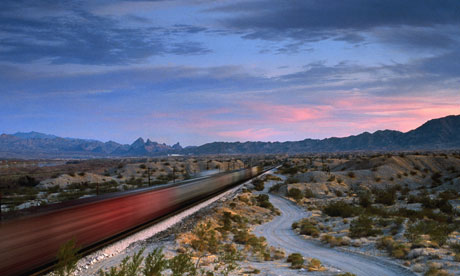
Christian Wolmar is in love with railways. He writes constantly and passionately about them. He is their wisest, most detailed historian and a constant prophet of their rebirth. So America, from 1830 on, from a few, tentative miles of track to a quarter of a million miles only 80 years later, is a story that grips his imagination.
Here's Isaac Dripps, a 21-year-old engineer, putting together an imported Robert Stephenson locomotive – the John Bull – from scratch, as though it were some Meccano kit, then inventing a cowcatcher to speed its path across the prairies. Here's General Joseph Johnston using the tiny Manassas Gap railroad over the Blue Ridge mountains to help win the battle of Bull Run where Stonewall Jackson earned his nickname. Here are the sweating (and dying) teams from Union Pacific and Central Pacific battling it out on their race west.
Wolmar doesn't have to invent the romance of the railways. That romance is clear on page after page of wonderful storytelling through triumph, disaster, ambition, corruption and death. Railways were the foundation of modern America. They joined it together, made it a nation and helped build its wealth. Long before President Eisenhower built the interstates, the age of steam turned a raw new world into a global power.
And yet, in a perverse way, the decades of pell-mell growth are less fascinating than what came after: the years of decline and fall into seeming disregard as Detroit became master of the roads and Boeing took charge of the skies. Maybe Wolmar doesn't find that part of the saga – the final third of his revolution – as compelling as the century that went before. Retreat doesn't lift his spirits or fire his passion. But the tangle of failure, frailty and faint-heartedness he unpicks here goes far beyond mere romance: it resonates and crosses borders of national experience; it tells us something vital about the nature of railways we still struggle to learn to this day.
Who, looking back to the rapacious era of the Vanderbilts and Drews, would have thought of America's railways as anything but the apotheosis of a market free-for-all? Who could have dreamed that today, and indeed since the moment in 1971 when Richard Nixon performed extraordinary obsequies, the US runs its inter-city passenger trains as a nationalised industry called Amtrak? But the harsh truth is that railways – even on the greatest network in the world – could never find a way to make steady profits or discover an assured future. They needed tax breaks and all manner of fixes from the moment the first rail was laid. The massive cost of building and maintaining infrastructure was always a weight they could not bear. And the concept of providing a service to a regular timetable – trains sometimes full, sometimes empty, but always there when you needed them – never took complete hold.
As good metal roads began to link towns (rather than turning into dust tracks a few miles from Main Street), as states and cities scrambled to build their own prestige airfields, so the whole purpose of passenger trains was called into question. Were they luxurious travel for the rich, with gyms, string quartets, swimsuit modelling and Sunday worship on the long haul from Chicago to Seattle? Was the future in Metroliners, fast, smooth and electric, linking the major hubs of the east coast? Fundamentally, did speed or the experience of train journeying matter most? One moment the emphasis was on getting there fast, the next on lying back with your feet up and all the free patisseries you could eat.
The way America's railroads had been built in the first place – a morass of different companies and different, unplanned lines – meant incoherence, consolidation and at last (as in Britain) the collapse of regional behemoths into the arms of an unenthusiastic government. The need to grow had given the Brotherhood of Locomotive Firemen and Enginemen (among others) their chance. You couldn't change from steam to diesel without carrying steam firemen along for the ride. You couldn't – final imbecility – take the Burlington Zephyr the 1,034 miles from Denver to Chicago without changing crews eight times (or every two hours for a full day's pay as defined in antique union agreements).
Freight mostly kept chugging along. The network is still 90,000 miles strong to this day. New light-rail services have begun to spring up around go-ahead cities as turnpikes coagulate and global warming looms closer. The future is not entirely bleak. In California, the Obama administration is "stimulating" more high-speed links.
But back in Penn station recently, taking a slow Amtrak from New York to DC, I found myself herded into an airport-style waiting pen and charged nearly five times the cost of a bus taking only 45 minutes longer. Where's the romance in that? If you love the hum of the wheels and of history, then Christian Wolmar is your man. If you're a pragmatic old misery-guts, counting pennies and minutes, then romance doesn't quite do the job.

